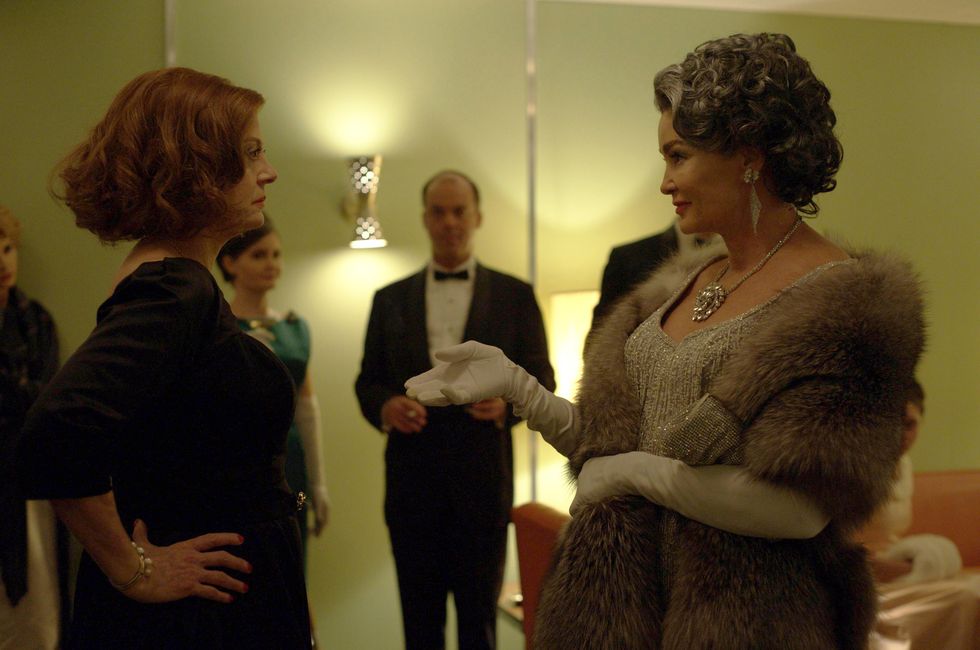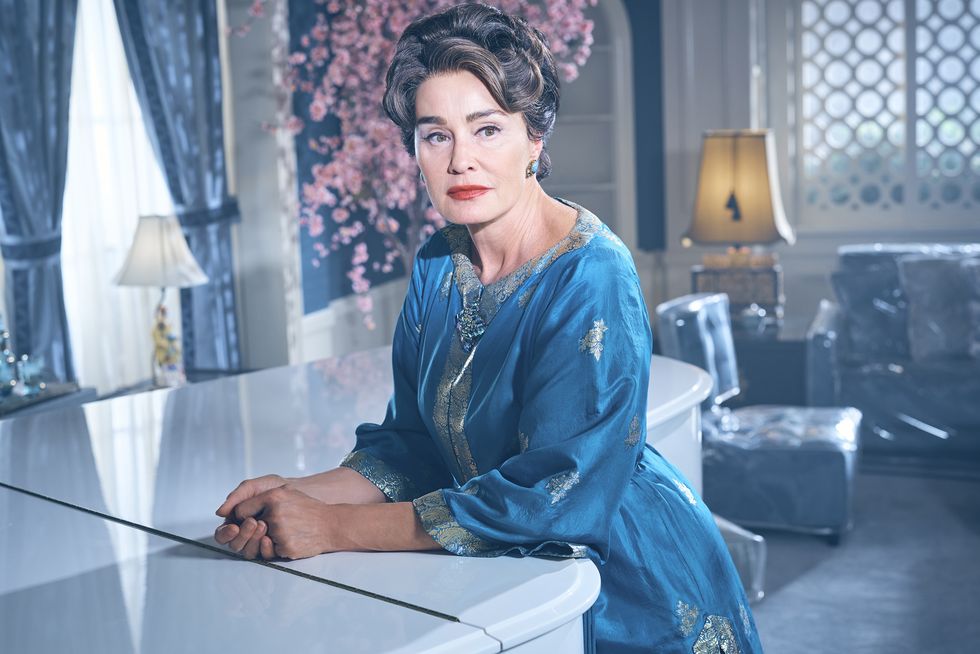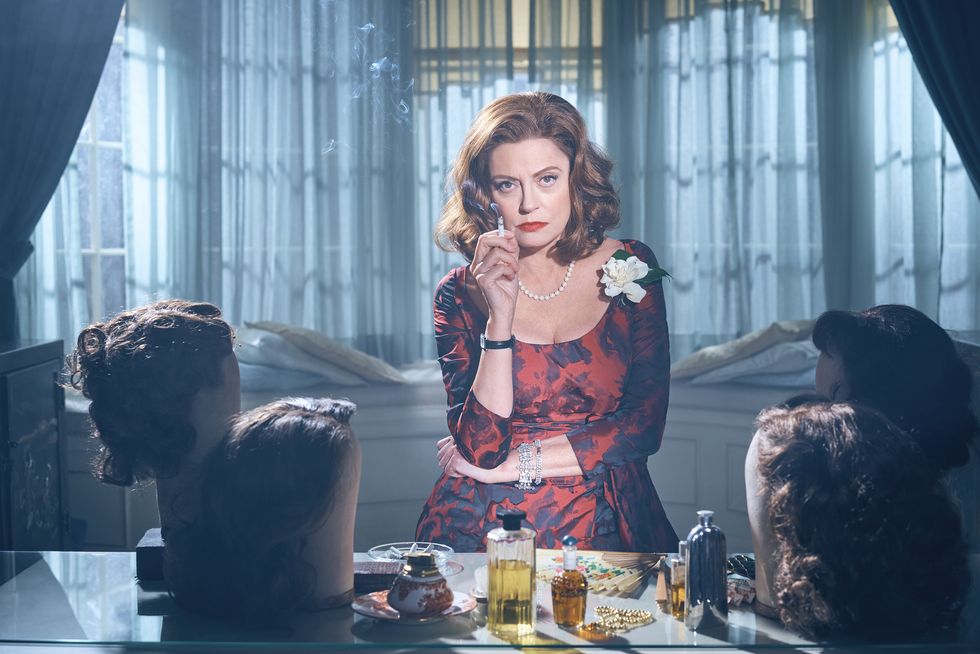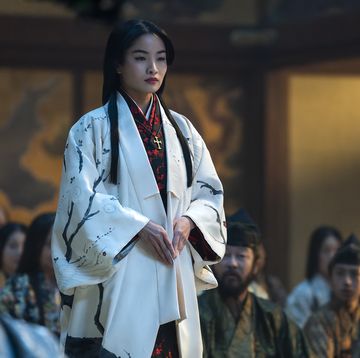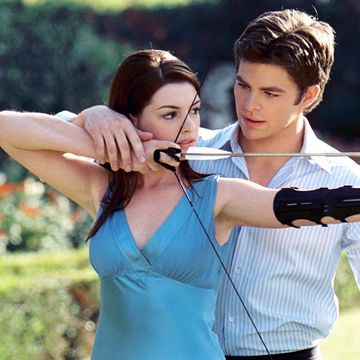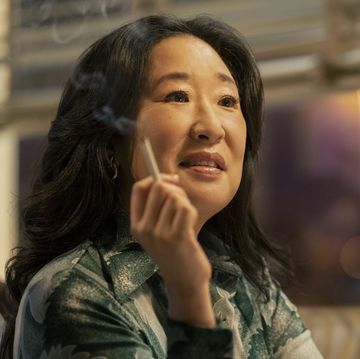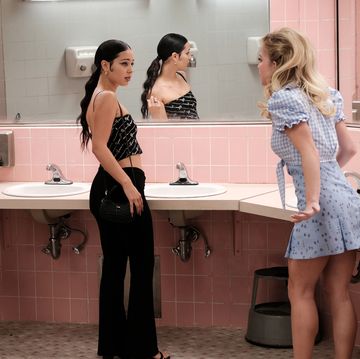On the night of the 89th Academy Awards, actress Brie Larson tweeted a picture of herself hugging her pal, Emma Stone, who had just won the award for Best Actress in a Leading Role. Larson won the same award herself last year, at the age of 26. Along with Jennifer Lawrence, who won in 2013, Stone's win meant that three of the last five Best Actress winners were in their twenties. By comparison, the youngest recipient of the Best Actor award was Adrien Brody in 2003, who was 29 at the time—still the only 20-something to have won the award.
Starlets, ingenues, whatever you want to call them: It's clear that Hollywood loves a young actress. Yet once these actresses age, once their skin starts to sag and wrinkle, Hollywood has no idea what to do with them, pushing them into obscurity or relegating them to mom roles.
This is the thesis behind Feud: Bette and Joan, the latest series for FX by showrunner Ryan Murphy. The show takes place in 1962, a dramatization of the real-life making of the psychological horror movie Whatever Happened to Baby Jane? The original starred Bette Davis and Joan Crawford (portrayed here by Susan Sarandon and Jessica Lange, who seem to be having the time of their lives). Both Davis and Crawford were in their fifties when the film was made; though they were lauded Oscar winners (twice over, in Davis' case), both were struggling to find work in Hollywood at the beginning of the '60s.
Feud is lush and indulgent in all the best ways. A veteran of Glee and American Horror Story, Murphy has never pretended to have an interest in subtlety. This over-the-top MO leads to a lot of blunt conversations about the nature of women in show business. Throughout the series, Murphy reiterates the point: Hollywood is sexist and ageist, and it's older women who consistently get the fuzzy end of the lollipop. The characters speak in tweet-ready truisms. "You know how it is," quips Crawford's facialist in the pilot. "Men age and they get cheered. Women age, they get lost." In that same episode, gossip columnist Hedda Hopper (played by Judy Davis) explains the system to Crawford: "Men built the pedestal, darling, not me. There's only room for one goddess at a time."
Plus, Feud suggests, the pressures this sexism creates lead to infighting between women. Baby Jane was supposed to be Davis and Crawford's triumphant return to Tinseltown, one that would ideally land them Oscars and more film roles. The stakes were high; both actresses knew this. But the two had already resented each other for decades. Being forced to work together on an unorthodox project and fighting for what little attention was available to women of a certain age made them downright vicious. In the show, we see Crawford and Davis willingly lean in to the fight, playing it up for the press in order to garner publicity for their movie—and themselves. Sure, the game might actually hurt them, but abstaining isn't an option, either.
None of this is exactly new. The one thing older women in Hollywood have always been allowed to do is play older women being pushed aside. Whatever Happened to Baby Jane? itself was an exploration of aging, show business, female competitiveness, and the crossroads of all three. Baby Jane (Davis's character) was a child star, spoiled and petulant. Her demure sister, Blanche (Crawford), enjoyed the limelight in her twenties, until a mysterious accident effectively ended her career, confining her to a wheelchair. In the 1962 film, Blanche and Jane are roughly middle-aged—so, ancient by Hollywood standards—isolated from the rest of the world and reliving former glories through their old movies.
This subject matter was also well trod in Crawford and Davis' respective filmographies. One of Davis' most iconic roles was as celebrated actress Margo Channing in 1950's All About Eve, in which Channing contends with a younger actress who seems intent on replacing her. (All About Eve was released the same year as Sunset Boulevard, which featured Gloria Swanson as Norma Desmond, a deluded former film star awaiting her great comeback.) Crawford won her Oscar for the title role in Mildred Pierce: a single mother desperate to give her teenage daughter the life she never had. Mildred opens a chain of restaurants, but Veda, her spoiled, social-climbing daughter, is intent on a life of attention and glamour.
While its critique of Hollywood's ageism is pointed, Feud doesn't push the conversation forward that much. Crawford, Davis, and other major actresses of their era were victims of the sexist Hollywood system, but they also benefited from it in a way that only white women could. Maidie Norman, the African American actress who played Elvira Stitt in Baby Jane, has been omitted from Feud. As Ira Madison III, writing at MTV News, points out, Norman's absence is a notable one—she was a smart and strong-willed actress who rewrote her lines to make them more realistic. (Not incidentally, only one black woman has ever won the Academy Award for Best Actress.) Class, too, goes under-explored. Crawford's maid in the show, who goes by the mononym Mamacita (Jackie Hoffman), seems to exist only to prop up the more privileged women. She chastises Crawford's nameless gardeners for asking about their overdue pay and offers aspiring film director Pauline Jameson (Alison Wright) inspiring platitudes about female ambition while displaying none of her own.
And yet, through its clear broadcasting of the systemic sexism that has prevailed to this day, Feud tries to be an antidote to some of the problems that persist in Hollywood. Its stars are bona fide legends; Sarandon has four Oscar nominations and one win (the most recent in 1996), and Lange herself has four nominations and two wins (most recently in 1995). But it's telling that two of the most compelling roles they've had in recent years are as aging actresses who themselves are portraying aging actresses. Meta? Yes. Acceptable? Not really.
While movie roles for non-20-something actresses do exist, they don't come in the number and variety their male counterparts get (for comparison, the majority of Best Actor Oscar winners have been in their forties or older). But it is getting better; television in particular is leading the way. Ryan Murphy's other major franchise, American Horror Story, has been keeping Lange busy with work for years. Better Things has Pamela Adlon playing a fictionalized version of herself: a single mother and actress dealing with many of the same pitfalls as Davis and Crawford, just with updated technology. As Madison pointed out, Viola Davis won a long-overdue Academy Award this year, but it took being cast as the lead in How to Get Away With Murder before Hollywood properly took notice.
Sarandon and Lange will likely land Emmy nominations for their roles in Feud. White women over 50 have been increasingly represented at major TV awards shows in recent years, for complicated, nuanced roles in House of Cards, Veep, Divorce, and Grace and Frankie. Major awards aren't the only indicator of progress, of course, but they still provide empirical proof of how far we've come and how far we still have to go. These nominations and wins provide a solid inch, but what Hollywood needs is a mile.
As for our heroines, Davis would go on to score an Oscar nomination for her role as Baby Jane Hudson. But on Oscar night she would lose to the 31-year-old Anne Bancroft. Five years later, Bancroft would perform in The Graduate as Mrs. Robinson, a middle-aged woman who seduces recent college graduate Benjamin Braddock. Benjamin was played by Dustin Hoffman—who is only five years Bancroft's junior.
Feud airs on FX Sundays at 10 P.M.
